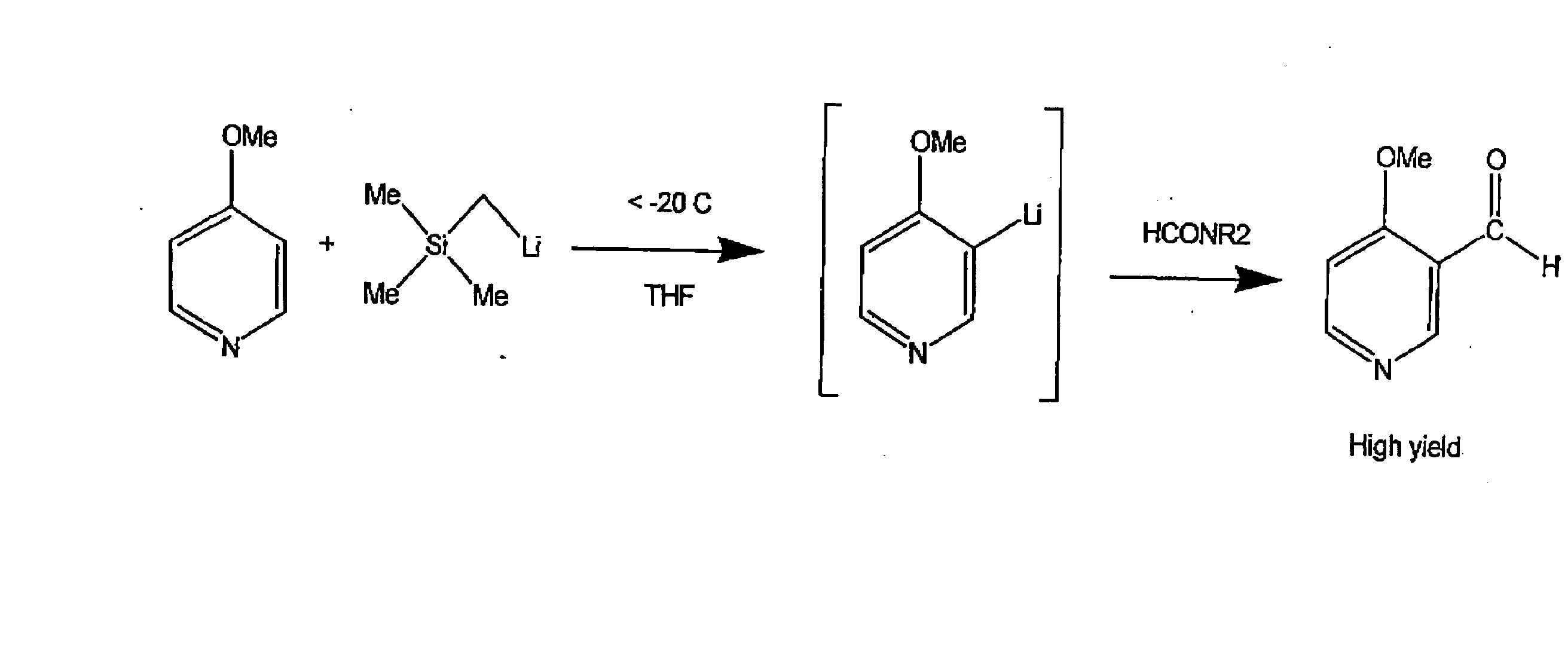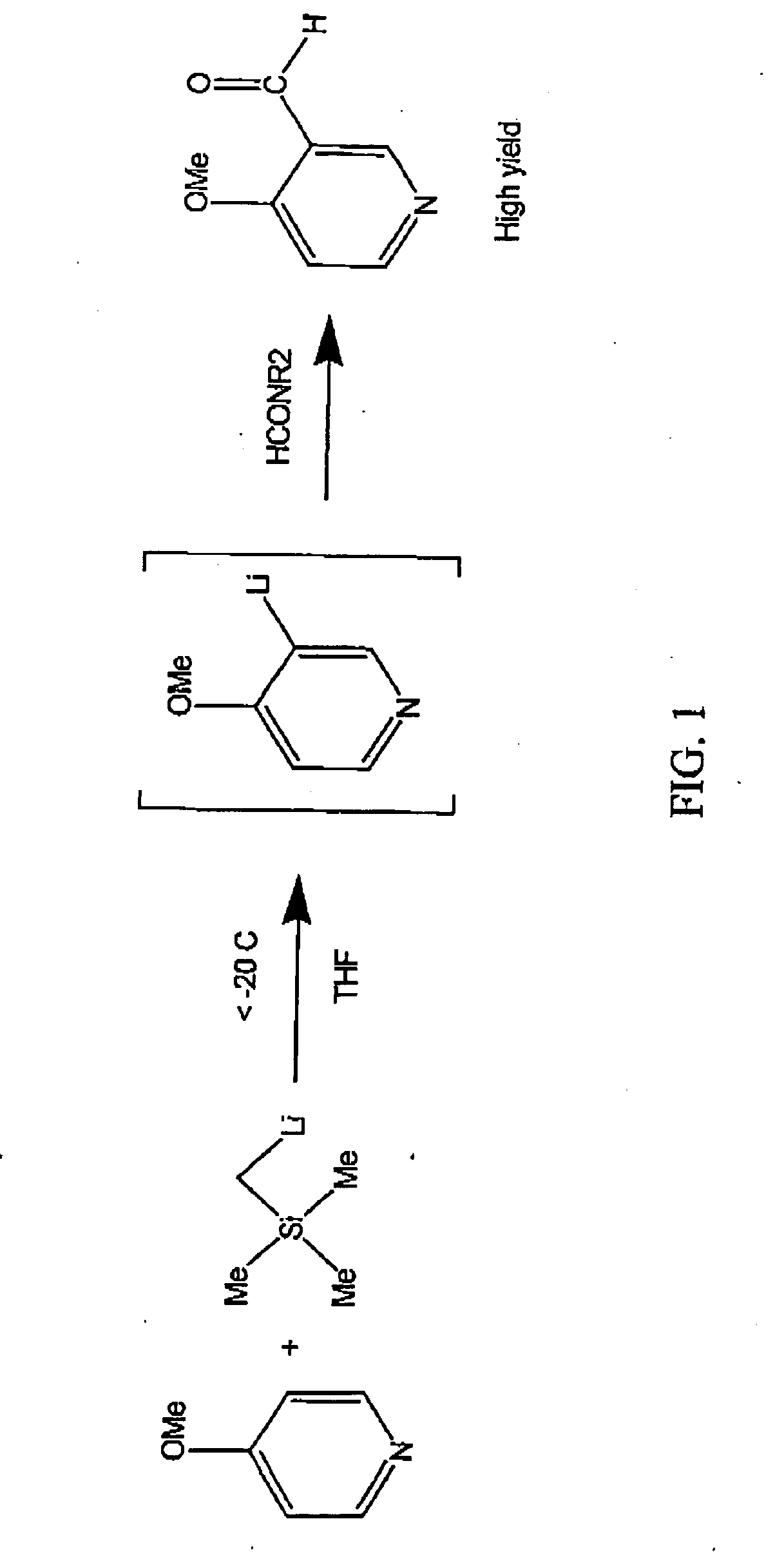Using alkylmetal reagents for directed metalation of azaaromatics
a technology of azaaromatics and alkylmetal reagents, which is applied in the field of metalation of chemical compounds, can solve the problems of insufficient strong base of lithium amide to completely deprotonate azaaromatic compounds, low yield of functionalized azaaromatics produced by deprotonation with lithium amides, and undesirable use of other alkyllithium reagents, such as n-butyllithium,
- Summary
- Abstract
- Description
- Claims
- Application Information
AI Technical Summary
Benefits of technology
Problems solved by technology
Method used
Image
Examples
example 1
Deprotonation of Azaaromatic Using (trimethylsilylmethyl)lithium
[0028] A solution of (trimethylsilylmethyl)lithium (106 mL, 12.8 weight percent in hexanes) was charged to a 250 mL 3-neck round-bottom flask and cooled to −40° C. A solution of 4-methoxypyridine (10.0 g) in tetrahydrofuran (THF) (111 mL) was added at less than −30° C. over one hour. The lithiation was complete after about 1.5 hours. 1-Formylpiperidine (10.6 g) was added at −35° C. over 5 minutes. After 1.5 hours the reaction mixture was quenched with acetic acid (15 mL) and water (35 mL). The aqueous layer was separated and washed with 4×25 mL EtOAc. All organic layers were combined, dried over MgSO4 and concentrated in vacuo to leave 16.0 g of yellow oil that crystallized on cooling. After trituration with 30 mL hexanes / 1 mL isopropyl alcohol, this material was 96.5% pure by GCarea % (13.02 g, 99% yield, corrected for assay). Recrystallization from IPA / hexanes (1:3) gave an 83% yield of desired product as pale yellow...
example 2
Deprotonation of Azaaromatic Using (trimethylsilylmethyl)lithium
[0029] A solution of (trimethylsilylmethyl)lithium (22 mL, 13.8 weight percent in hexanes) was charged to a 100 mL 3-neck round-bottom flask and cooled to −50° C. A solution of 2-fluoropyridine (2.0 g), THF (25 mL) and diisopropylamine (0.13 mL) was added at less than −50° C. in 1 minute. After 3 hours, 1-formylpiperidine (2.4 g) was added in 1 min at less than −50° C. The mixture was allowed to warm to room temperature and stir overnight. The reaction mixture was quenched with acetic acid (3 mL) and water (7 mL). The aqueous layer was separated and washed with 3×25 mL MTBE. All organic layers were combined, dried over MgSO4 and concentrated in vacuo to leave 3.79 g of brown oil. This oil was chromatographed through silica gel, eluting with 15% EtOAc in hexanes, to afford 2.24 g of 92.4% pure 2-fluoro-3-pyridinecarboxaldehyde (90% yield, corrected for assay).
example 3
Deprotonation of Aazaaromatic Using (trimethylsilylmethyl)lithium
[0030] A mixture of 2-methoxypyridine (23.2 g) and diisopropylamine (1.35 mL) in THF (223 mL) was added to (trimethylsilylmethyl)lithium (218 mL, 13.8 weight percent in hexanes) at −20° C. The lithiation was 84% complete after 7 hours. Tri-isopropylborate (40.8 g) was added at −20° C. over 40 minutes. The mixture was stirred overnight at ambient temperature. 5 percent NaOH (aq, 225 mL) was added. The aqueous layer was removed and brought to pH 5 by adding 10% HCl (aq). The resulting white precipitate was isolated by filtration. After drying, 22.23 g of 2-methoxypyridine-3-boronic acid was obtained (68% yield).
PUM
| Property | Measurement | Unit |
|---|---|---|
| temperature | aaaaa | aaaaa |
| temperatures | aaaaa | aaaaa |
| temperatures | aaaaa | aaaaa |
Abstract
Description
Claims
Application Information
 Login to View More
Login to View More - R&D
- Intellectual Property
- Life Sciences
- Materials
- Tech Scout
- Unparalleled Data Quality
- Higher Quality Content
- 60% Fewer Hallucinations
Browse by: Latest US Patents, China's latest patents, Technical Efficacy Thesaurus, Application Domain, Technology Topic, Popular Technical Reports.
© 2025 PatSnap. All rights reserved.Legal|Privacy policy|Modern Slavery Act Transparency Statement|Sitemap|About US| Contact US: help@patsnap.com


